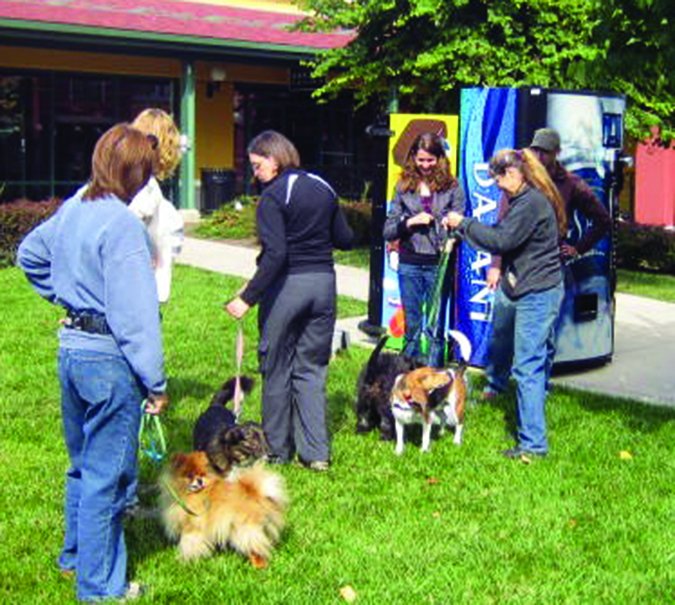CONSTRUCTIONAL AGGRESSION TREATMENT OVERVIEW
What you can do…
– Read and watch videos about the CAT procedure and counter-conditioning to determine which approach is more appropriate for you and your dog.
– Talk to other dog owners and trainers (in person and online) to expand your knowledge base about the procedures.
– Look for a behavior professional experienced with the procedure to help you with it.
Aggressive behavior in their beloved companions is an incredibly challenging and upsetting problem for most dog owners to deal with. The problem is painfully public -and the public is equally free with accusations and advice for the hapless owner of a reactive dog. Many training “solutions” that people try are inhumane, ineffective, or both. Some owners respond by sequestering their dogs to their home “quarters” -sometimes for life.
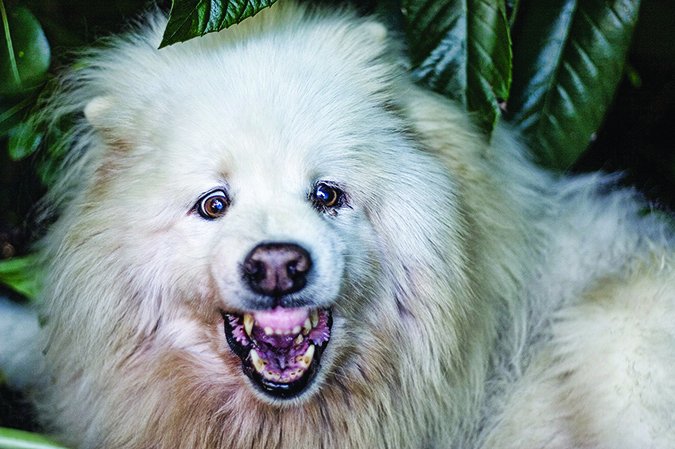
In early 2008, I was excited to learn about a very new behavior modification approach for dealing with aggressive behavior in dogs. I described the technique, known as Constructional Aggression Treatment (CAT), in Whole Dog Journal’s May 2008 issue. “Modifying Aggressive Dog Behavior” explained the CAT program, and described my first experience (and positive results) using the technique. The subject was Juni, an eight-year-old Pit Bull-mix belonging to my friend and colleague, Jolanta Benal.
CAT was developed and tested by graduate student Kellie Snider for her master’s thesis, under the direction of Dr. Jose Rosales-Ruiz at the University of North Texas. The pair made quite a splash when they introduced CAT to the dog-training world, since CAT utilizes operant conditioning (negative reinforcement) to modify the subject’s behavior, rather than the more commonly used classical conditioning. (In classical conditioning, a positive stimulus is paired with an aversive one to deliberately improve the dog’s association with, and response to, the negative stimulus).
Since then I’ve had the opportunity to use CAT a number of times, with varying degrees of success. I’ve also participated in the ongoing behavior and training industry discussion about the technique. To say it’s a controversial approach to behavior modification is an understatement. But I still think it’s a valuable tool for use in some behavior cases.
The Principles of Operant Conditioning
Operant conditioning is a basic element of the science of behavior and learning. It says that all living things repeat behaviors that are rewarding to them, and avoid behaviors that make bad things happen. The four principles of Operant conditioning are:
1. Positive reinforcement (written in behavioral shorthand as “R+”): The dog’s behavior makes a good thing happen, so the behavior increases. He sits, and you give him a treat. He likes getting treats, so he sits more.
2. Positive punishment (P+): The dog’s behavior makes a bad thing happen, so the behavior decreases. He jumps up and you knee him in the chest (not recommended!) He doesn’t like a knee in the chest, so he jumps up less.
3. Negative punishment (P-): The dog’s behavior makes a good thing go away, so the behavior decreases. When he jumps up to grab the ball from your hand you hide the ball behind your back. He doesn’t want the ball to go away, so he jumps up less. (Negative punishment works best if you follow it with positive reinforcement for the behavior you want instead. When he sits you throw the ball [R+] so he sits more and jumps up less.)
4. Negative reinforcement (R-): The dog’s behavior makes a bad thing go away. Your puppy struggles when restrained, so you hold him until he becomes calm, and then let him go. Calm behavior makes restraint go away. He doesn’t want to be restrained, so he learns to be calm in order to make restraint go away (not recommended).
Because training methods that involve intimidation, coercion, and physical force can cause undesirable side effects, including fear and aggression, positive trainers use primarily positive reinforcement and secondarily negative punishment; they generally avoid the use of negative reinforcement, and especially avoid positive punishment. 0n those occasions where negative reinforcement may seem appropriate, it should be applied as gently as possible, avoiding a strong response from the dog. In the case of CAT, “gently” means presenting the aversive stimulus at sub-threshold intensity (otten this is “distance”) and being careful to increase intensity (decrease distance) only as the subject dog is can handle it.
CAT Controversy
The CAT approach is controversial among positive trainers for several reasons. The foremost is that the technique utilizes negative reinforcement.
To use negative reinforcement, something that is aversive to the dog is applied, and not withdrawn until the moment the dog changes his behavior in the desired way. For example, a dog pulls on the leash; this is a behavior the handler wants to stop. The handler increases the tightness of the leash, in a way that is uncomfortable for the dog; the tight leash is aversive. The dog moves back toward the handler (displays the behavior the handler wants), and the and the leash slackens, relieving the pressure and the dog’s discomfort.
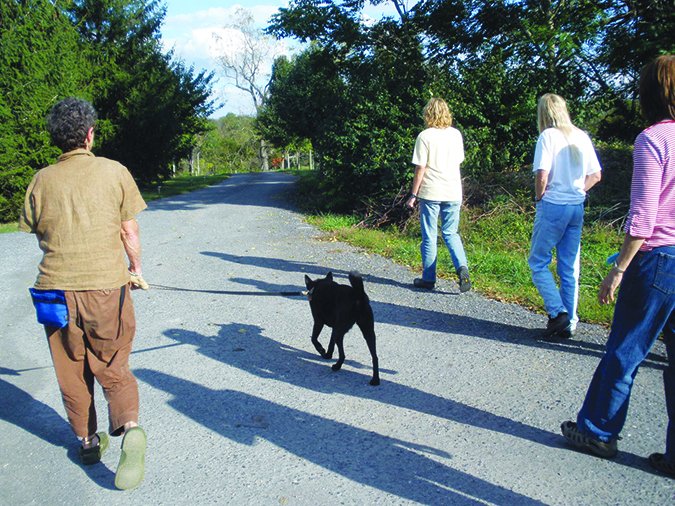
Positive trainers try to avoid the deliberate use of aversives, for many reasons. To name just a few, the application of aversives can make many dogs “shut down” or lose interest in working with their handlers. They can increase a dog’s anxiety and fear. They can damage the relationship between the dog and his handler. In fact, in the past, I have been one of the louder voices in opposition to the use of negative reinforcement in “dog-friendly” training programs.
However, there are some sound reasons for using a certain type of negative reinforcement in a CAT program. Here’s how negative reinforcement works in the CAT procedure:
Most dogs who display aggressive behavior toward other dogs are trying to scare the dogs away; they are threatened or stressed by other dogs. In most cases, the behavior works; growling, barking, lunging, and snapping often makes the other dog leave -or at least, makes the owners depart with their dogs! From the “aggressive” dog’s point of view, the aggressive behaviors (growling, barking, lunging, snapping) have been reinforced: they worked, and the other dogs went away. And because behaviors that are reinforced get stronger, the dog is more likely to growl or snap at the next dog, and the next, etc.
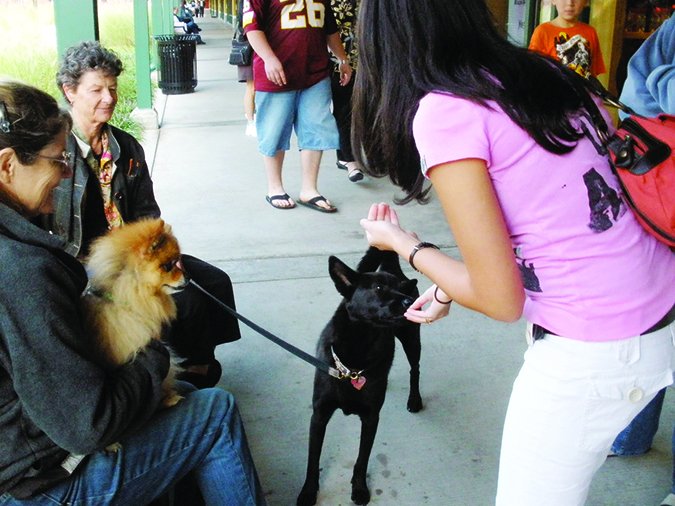
In a CAT procedure for a dog-aggressive dog, the presence of the “other” dog is considered the aversive. The “subject dog” is deliberately exposed to another dog (the aversive is applied) in carefully controlled, low-intensity conditions, until the subject dog offers the desired behavior: some small decrease in his level of stress or tension. Then the aversive (other dog) is immediately whisked away. The idea is that the subject dog will realize that he can reliably make the aversive “other dog” leave if he exhibits calm behavior; each time he does this, he is rewarded -reinforced -by the quick exit of the other dog. His calm behavior around other dogs increases.
Most positive trainers (including myself) are opposed to the use of aversives, which by definition inflict pain, discomfort, fear, and anxiety on the dog. In CAT, however, you present the subject dog with an aversive stimulus that he is often exposed to anyway. For anyone who lives in a populated neighborhood and wants to take their dog out of the house, other dogs are not avoidable. Consider the dog-reactive dog who sees numerous other dogs daily on his walks around the block, or even from his own backyard, as dogs and their humans pass by on the sidewalk. People who walk their dogs in urban neighborhoods where dogs are popular may encounter more than 100 dogs each week.
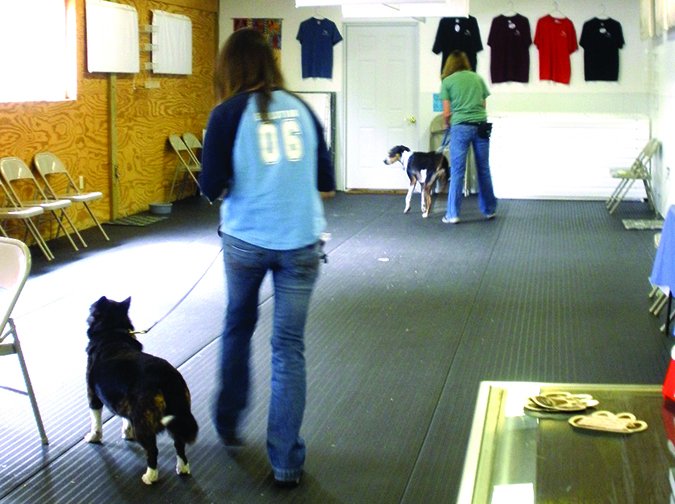
Some positive trainers argue that counter-conditioning and desensitization (CC&D) are less-stressful tools that can be used to change how a dog-aggressive dog feels about other dogs -and it’s true, these are great tools that help many dogs. In a CC&D program, you present the aversive stimulus (another dog) while rapid-fire feeding high-value treats to the subject dog in an effort to change her association with the other dog. The idea is that she learns to associate the presence of other dogs with good things happening; she starts to feel better about other dogs. Eventually, one hopes, her behavior will improve as well.
CAT takes a different tack. The goal with CAT is to help the dog learn that a new behavior now works to make the neutral dog go away. In both methods, you present the aversive stimulus to the subject (reactive) dog, and in both methods, ideally, you present the stimulus sub-threshold -meaning the “other” dog is presented closely enough to the subject dog for him to notice the other dog, but far enough away so that he doesn’t respond with the reactive (growling, barking, lunging) behaviors. The “sub-threshold” presentation is an important part that sometimes gets missed in both CAT and counter-conditioning.
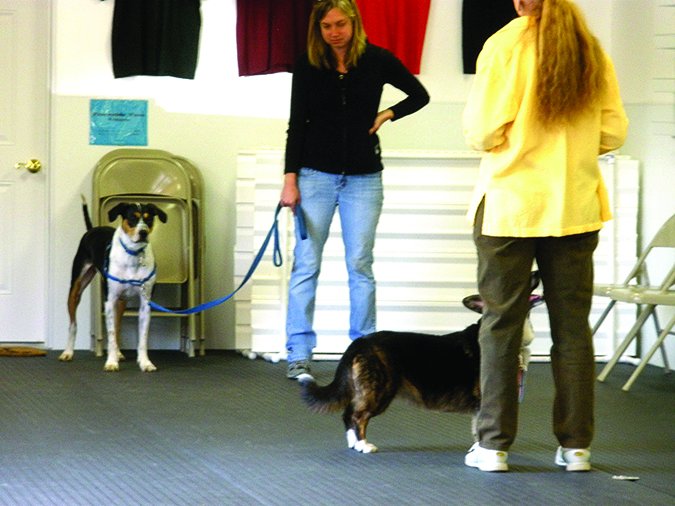
I may have fueled some of the opposition to CAT with my description of my first use of the CAT procedure with Juni in the May 2008 issue, and my subsequent release of the video footage of our sessions with him.
As I said, the goal in both a CC&D program and CAT is to present the aversive stimulus at a sub-threshold level, where the subject dog notices and shows some signs of stress, but isn’t barking and lunging or demonstrating other over-threshold (extreme) behaviors. But with Juni there was no sub-threshold; if he saw another dog at any distance, he barked and lunged.
Jolanta had done years of counter-conditioning with Juni, and was able to manage his behavior by feeding him in the presence of other dogs, but had reached an impasse in terms of actually modifying his reactivity. After watching Juni’s video, CAT co-developer Kellie Snider commented that Juni was one of the most difficult cases she had seen. We did get a lot of extreme behavior, and it made us all uncomfortable. And it should not be considered as representative of how CAT should look.
And yet, it worked. Jolanta reports that Juni’s behavior has continued to improve, and the quality of their lives together is greatly enhanced as a result of their CAT experience. Nevertheless, ideally, in a CAT program, the dog is not pressured by the aversive stimulus (other dogs) to the point that he erupts with over-threshold behaviors.
Other Critiques of CAT
Some CAT opponents argue that CAT is flooding, a behavior modification technique generally regarded as inhumane. Flooding is performed by introducing an aversive stimulus at full intensity and maintaining it until the subject achieves learned helplessness -he simply shuts down and gives up. That’s not what happens in CAT.
While a subject dog may try shutting down as a behavioral strategy, when CAT is properly carried out, the “shutting down” behavior is recognized as such by the handlers and isn’t reinforced. Signs of shutting down include lying down, consistently looking away from the neutral dog, and stopping all behavior. Reinforcement in the case of a dog-reactive dog comes when the neutral dog goes away.
When the subject dog tries shutting down, the handler of the neutral dog remains in place -still sub-threshold. The neutral dog is moved away only when the subject dog offers a small piece of a calm behavior that isn’t shutting down, such as opening his mouth, blinking, or glancing toward the neutral dog. “Look, dog,” the procedure says, “you can make the neutral dog go away by offering a new behavior. You don’t have to shut down; you are not helpless here.”
Others suggest that CAT, when it succeeds, is merely habituation -the subject dog gets used to the presence of the sub-threshold presentation of the neutral dog and stops reacting. There’s nothing wrong with habituation, and it probably does play at least a partial role as the subject dog comes to realize the neutral dog is not a threat. However, mere habituation doesn’t explain the remarkable switchover that occurs in some CAT procedures, when the subject dog begins demonstrating clear affiliative behavior (“Come closer, I’d like to get to know you!”) and is able to interact in a friendly manner with multiple dogs in fairly rapid succession, without habituating to each one.
Additional arguments against CAT include the high cost, the considerable block of time required for the initial procedure and follow-up training, and the difficulty owners may have in generalizing their dogs’ new behavior when they no longer have their CAT coach working with them. I acknowledge the reality of these concerns.
For private CAT sessions, I schedule three hours a day, three days in a row. I certainly don’t have clients flocking to my training center eager to pay the fee for nine hours of my time. For the relatively small pool of clients I have done CAT with, even many of the ones who have had great success have found it very challenging to generalize the behavior with their dogs back at home.
While Snider strongly recommends doing the procedure in the dogs’ own environment to avoid some of the generalization challenges, many of my clients travel long distances and stay here for the three days, and it’s not financially feasible for them to transport me to their homes and pay for three full days of my time. So we do it at the training center, and help clients identify ways to practice when they get home.
CAT Is All About Manipulating Reinforcers
The key to a successful CAT procedure is being able to identify, and manipulate, whatever it is that’s reinforcing the dog’s unwanted behavior, in order to be able to reinforce a different, more desirable behavior. It’s clearly reinforcing to fearful dogs to have the scary thing -dog, human, or whatever -go away. But that’s not always the case. If a CAT procedure isn’t working, you may have to re-evaluate your assumption of how the dog is being reinforced, and alter the procedure accordingly.
Some of the easiest CAT procedures I’ve done have involved dogs who were reactive because they wanted to be social with the approaching dog, and their frustration with being denied that pleasure turned into barking and lunging on-leash behavior. With those dogs, we do a “reverse” CAT procedure. They are reinforced when the neutral dog comes closer, because they desperately want to greet the other dog. In that case, calm behavior makes the neutral dog-and-handler come closer, while reactive behavior makes the neutral dog leave.
CAT Camp
My most recent CAT encounter was a four-day workshop held in early October 2009, at my Peaceable Paws training center in Fairplay, Maryland. The group turned out to be a perfect microcosm of my experiences with CAT in the past 18 months.
I had three dog/human teams registered for the workshop, and four auditors, as follows:
- Melanie and Adam Kornides, of Alexandria, Virginia, with their Beagle, Charlie. The Kornides had worked with Charlie at All About Dogs in Woodbridge, Virginia, doing counter-conditioning and desensitization in a Reactive Rover-style class for Charlie’s dog-dog reactive behavior. They felt they were stuck in their modification program; Charlie would still bark and lunge at most dogs in his neighborhood when he first spotted them. They were looking for a new approach.
- Katie Ervin of Hagerstown, Maryland, with her four-year-old Dobie/Hound mix, Harley. Katie is a Peaceable Paws trainer and owner of 4-Legged Friends pet-care service. Katie had done a great deal of counter-conditioning with Harley for his dog reactivity, and while she excelled at managing Harley’s behavior in the presence of other dogs (he has several rally titles), he could still be explosive if dogs got too close.
- Pam Courtleigh of Rockport, Massachusetts, with Bliss, a Chow-mix street-dog from Puerto Rico. When Bliss was found and rescued as a four-month-old pup, she had a deep laceration running the length of her back. Bliss was reactive to humans, not other dogs. Given the abuse she probably suffered as a street puppy, her mistrust of strangers wasn’t surprising. Pam had done an excellent job of helping Bliss learn to tolerate people, but the strikingly beautiful black dog was still uncomfortable and would sometimes snap if someone she didn’t know well reached over her head to pet her. Pam was worried her dog might one day bite someone.
My auditor/helpers were Judy Archer-Dick, of Spencerville, Indiana; Anne Gouiller-Moore, of Blackburg, Virginia; Connie Snavely, of Madison Heights, Virginia; and Silke Wittig, of Orangeville, Pennsylvania. All are trainers in their own right, eager to increase their education and experience with the CAT procedure.
Like others who have used, observed, or heard about the procedure, they had many questions and comments, and wanted more experience with CAT to help them sort through the controversial issues for themselves. Their observations added value for the working participants -multiple eyes, brains, and mouths can see, process, and share more information, and contribute to the sometimes-lively discussions. We also made good use of our auditors by drafting them as neutral dog handlers and photographers during the procedures. It was a highly educational experience for all.
Each CAT dog worked for one three-hour session for each of the four days, with a 15-minute break for canines and humans after about 45 minutes of work. Given the finite number of hours in a day, we worked two dogs simultaneously in one time slot each day (in separate locations), and one dog alone. Auditors chose which dog(s) they wanted to observe.
- Bliss: This medium-sized black dog first showed signs of discomfort at my approach when I was about six feet away. We started our work there, retreating when she showed some sign of relaxing, waiting for a 15-second recovery period, and then returning. Although she seemed to quickly accept my presence, I wasn’t sure she found my departure particularly reinforcing, and the auditors reported the same observation. Her affect was very flat -a common persona for Chows -and we all sensed we’d wait for a long time, if ever, to see affiliative behavior from Bliss in a CAT procedure.
We decided to experiment with a squeaky toy, which Bliss liked. I began squeaking it once and tossing it to her as I left, to make my departure more reinforcing to her. In essence, we were adding a positive association with my presence, and positively reinforcing my departure by providing something she liked. We were no longer doing CAT, but in very short order Bliss decided she liked me. When I sat in a nearby chair she came and rested her head on my knee. This, according to owner Judy, was her sign that she had accepted me, and indeed, from that day forward, I was her friend and could pet her anywhere without caution, including over her head.
If Bliss was that easy with positive reinforcement, it made little sense to me to painstakingly pursue the CAT procedure. Her owner agreed, as did the rest of the group, and for the remaining days of the workshop we gave Bliss positive associations with humans, and positively reinforced her for appropriate human-related behaviors. She quickly befriended the other workshop attendees, and on Day 4 accepted treats from several strangers at a nearby shopping mall. Judy also did counter-conditioning with her at the mall as shoppers who showed no interest in the dogs passed by.
In a follow-up report shortly after the workshop, Judy assured us that Bliss was doing well back at home with her ongoing counter-conditioning and positive reinforcement work.
- Harley: Like Juni, Harley had years of counter-conditioning and desensitization work under his collar. He had selected avoidance behavior as his primary line of defense in the presence of other dogs; if they got too close, he looked away. This behavior had been reinforced by Katie’s high rate of treat reinforcement as she passed by other dogs in close quarters at training classes, Rally trials, and other doggie events. Harley became reactive only if dogs invaded the space a foot around him. Katie was hoping to extinguish even that reactivity with the CAT procedure.
This was a challenge. Misreading his avoidance behavior for calmness, we approached to a distance of 20 feet with my Cardigan Corgi, Lucy, and waited for a sign. Nothing. Harley looked anywhere but at Lucy, but didn’t appear unduly stressed. We worked our way closer, still without any behavior that felt like progress. Finally Harley started lying down, a sure sign of shut-down. Katie tried to jolly him up in between sessions, but he would quickly lie down again, and it was clear we were making no headway. Time to regroup.

Putting our heads together, we realized that Harley did glance at Lucy when she was at the opposite end of the 80-foot room. We need to work with Lucy farther away, not closer. Just because he wasn’t exploding didn’t mean Harley wasn’t over-threshold. Avoidance was his “extreme” over threshold behavior. “Duh,” we said as we collectively slapped our foreheads at this epiphany.
We started over with Harley on Day 2, with Lucy 80 feet away, reinforcing him by increasing distance when he looked at her. We were able to reduce the distance fairly quickly initially, to about 40 feet, and then more slowly, to about 20 feet. We started seeing more active interest from Harley as Lucy approached, and tail wags as she departed. It was working!
Katie still had to do a lot of jollying in between approaches to keep Harley engaged, but he wasn’t trying nearly as often to lie down. Harley continued to make slow progress over the final two days of the workshop, but he never showed strong affiliative behavior to any of the neutral dogs. Katie reports that she hasn’t had much opportunity to practice CAT with him since the workshop; she continues to manage his behavior with treats when near other dogs.
- Charlie: This little Beagle was the star of the CAT workshop, and a textbook subject. It was as if he had read the research paper. On Day 1, my associate, Shirley Greenlief, did approaches with Bonnie -my very friendly, 35-pound Scottie/Corgi/Poodle. They quickly reduced distance and ended the day about 10 feet apart. By Day 2, Charlie was doing parallel walking with Bonnie, and on Day 3 he interacted with Bonnie and Missy, my bouncy Australian Shepherd.
When we tried doing approaches with Bliss, we discovered that Charlie was more uneasy with her. Perhaps it was her more serious demeanor, her sharply-pricked upright ears, the tail that curled over her back, or a combination of these, but Charlie was clearly tense with her, and we were able to approach within only about 20 feet.
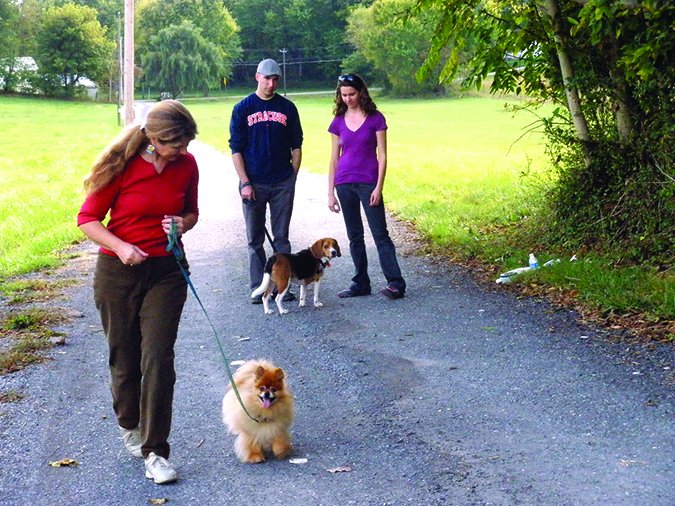
On Day 4, at the mall, Charlie delighted us all, interacting easily with the dogs he had met previously at the training center. He was still tense about approaches from Bliss, as well as from Myah, Shirley’s Siberian Husky, who, while demonstrably more relaxed and friendly than Bliss, also had sharply pricked ears and a curled-over-the-back tail. Charlie immediately accepted Lucy, whom he hadn’t previously met; she has sharp-pricked ears and a curled tail, but is half the size of Bliss and Myah. By the close of the final session, he was able to relax on the grass with all six dogs (Bonnie, Scooter, Missy, Lucy, Bliss, and Myah, and didn’t react to a couple of random dogs whose owners were walking them at the mall. Success!
Charlie’s owners have continued to work with CAT in their Washington, DC, neighborhood, under the guidance of CAT-experienced trainer Penelope Brown, owner of Phi Beta K9 School for Dogs, who has assisted me with several CAT procedures, including Juni’s. They report continued progress and success with Charlie’s CAT program at home.
When to Use CAT
Like much of what we do with our dogs, CAT is useful in some cases, but not others. It’s a useful tool to have and consider when appropriate, but I’d never say it should be used with every dog who has aggressive or fearful behaviors.
I’m often asked how I decide when to do counter-conditioning with a client and when to choose CAT. While Kellie Snider suggests that CAT works better if you haven’t tried other modification approaches first, I tend to use it with dogs for whom counter-conditioning hasn’t modified their dog’s behavior as much as they’d hoped. I freely admit I’m still heavily biased toward counter-conditioning, as evidenced by the fact that I’ve done maybe as many as a dozen CAT procedures in the last 18 months, while I do counter-conditioning programs with several new clients each week. I almost always try counter-conditioning first, and if we don’t see the improvement we hoped for, perhaps suggest CAT as an alternative somewhere down the road.
I think CAT is a helpful technique for dealing with some issues, but an especially valuable procedure for introducing a reactive dog to one specific dog. If your dog is reactive toward other dogs and you want to bring home a new canine family member, CAT can facilitate the introduction and new living arrangement. No worries about generalization -your dog only has to come to like the one new dog you’re bringing home.
In fact, when we adopted our new Pomeranian, Scooter, last spring, I was going to use CAT to introduce him to Dubhy, our dog-reactive Scottie. But Dubhy took one look at Scooter, got all soft and mushy, and welcomed Scooter into the Miller family with open paws. Dubhy had lived with a Pomeranian previously and the two had been good friends. I think Dubhy remembered.
Pat Miller, CPDT, is Whole Dog Journal’s Training Editor. Miller lives in Fairplay, Maryland, site of her Peaceable Paws training center. Pat is also author of The Power of Positive Dog Training; Positive Perspectives: Love Your Dog, Train Your Dog; Positive Perspectives II: Know Your Dog, Train Your Dog; and Play with Your Dog.


